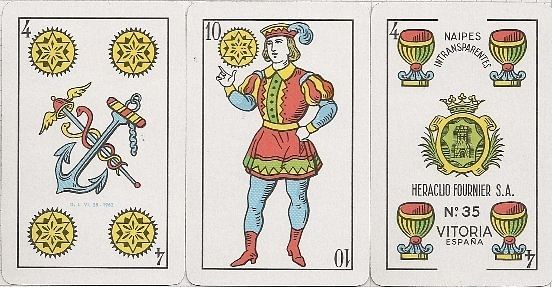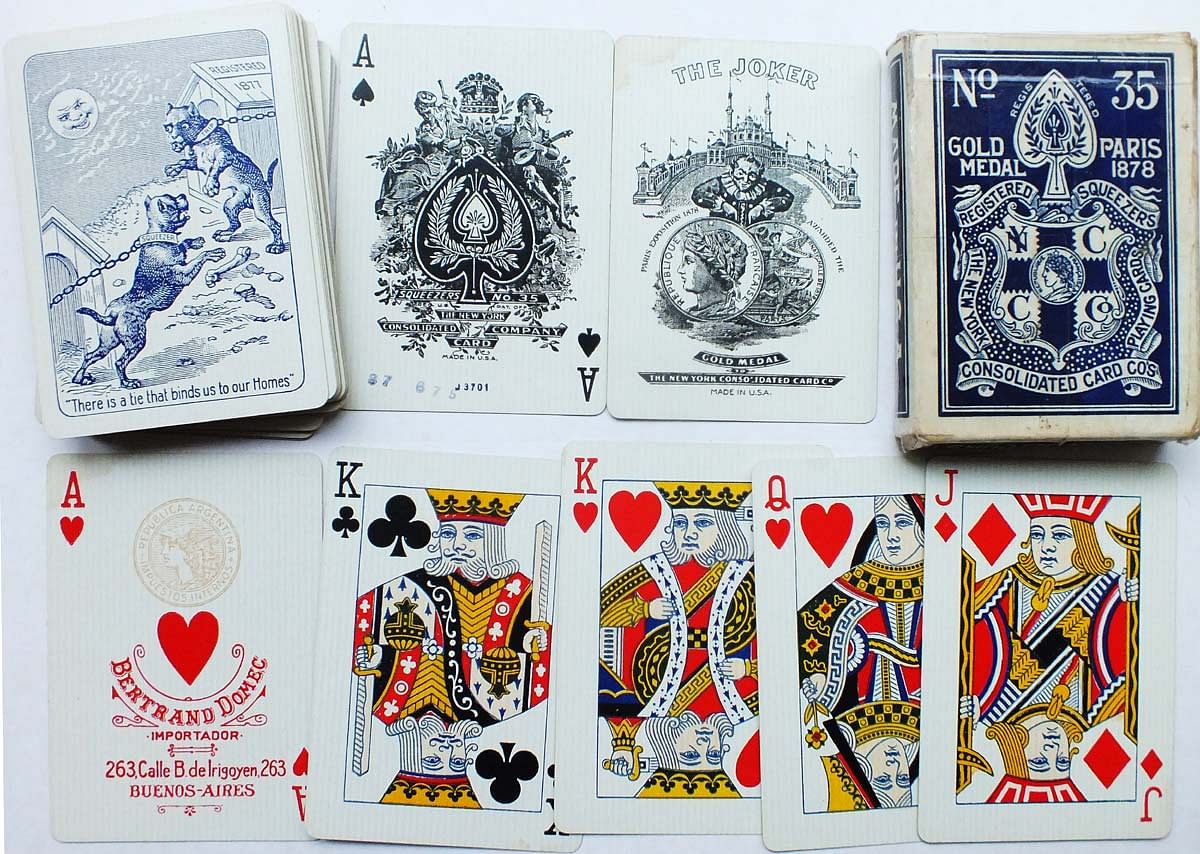How Did Playing Cards Get Their Symbols?
Most people don’t realize the amazing amount of history and engineering behind a simple deck of cards. Over the last 1,000+ years, playing cards have undergone a significant evolution as various countries have adapted them to feature colors, designs and symbols that best reflect their own unique cultures.
Today, we explore the facts about how we finally landed on the design that can be found on nearly every deck of cards in the world. Even super rare playing cards stem from everything in this article. Although they might now be more carefully stored and displayed, and certainly never used to cheat in a game of poker!
The Early Days
 The exact origin of playing cards is contested by historians to this day. Some reports suggest they may have surfaced as early as 9th century China during the era of the Tang Dynasty. However, during this time, they were believed to only be used as ornate gambling pieces for other games like Mahjong or Chess.
The exact origin of playing cards is contested by historians to this day. Some reports suggest they may have surfaced as early as 9th century China during the era of the Tang Dynasty. However, during this time, they were believed to only be used as ornate gambling pieces for other games like Mahjong or Chess.
It wasn’t until the late 14th century that we saw our first recorded account of playing cards being used in the ways we are accustomed to today. While living in a Swiss monastery, a German monk named Johannes wrote about the burgeoning popularity of playing cards and the variety of card games they were being used for.
The Evolution of Playing Card Suits
Latin Suits
Potentially inspired by tarot cards, European card makers began using Swords, Clubs, Cups and Coins as the suit symbols on their playing cards in the 14th century. Known as “Latin Suits”, this imagery can still be found on some Italian and Spanish playing cards to this day. Additionally, as “sword” translates to “spada” in Italian, and “espada” in Spanish, these symbols may have laid the groundwork for the modern suits we know today.

Germanic Suits and French Suits
Around the turn of the 15th century, the Germans developed their own suits: Hearts, Bells, Acorns and Leaves. This imagery was believed to be more indicative of German Life.
During this time, the French also began to insert themselves into the conversation by becoming the first card makers to split a card deck into two colors: red and black. This simplified color scheme allowed them to drastically improve production speeds.
The French also evolved the German suits to create the first iteration of what would ultimately become the suits we find in standard decks today. While they kept the Germanic “heart” symbols, the Bells were replaced with “carreaux” or “diamonds”. The Acorns also became “trèfles” (or clovers or clubs) and the leaves were transformed to “piques” (or pikes or spades).
English Suits
Right before the start of the 16th century, high taxes on playing cards forced French card makers to relocate their operations to Belgium. As a result, the English began importing French playing cards and eventually adopted the suit names we know today. Combining the translations of both the Italian and French designs, they formed the names: Clubs, Hearts, Spades and Diamonds.
Despite changing the names, these English cards still featured lavish French designs until the import of foreign playing cards was banned in the early 1600’s. Eager to continue capitalizing on the massive popularity of playing cards, the English began producing their own playing cards. In the late 19th century, the French designs were remodeled by Charles Goodall and Sons into the graphic symbols or “pips” commonly found on playing cards today.
Around this same time, Thomas De La Rue and the De La Rue printing company further streamlined playing card design in a way that allowed them to increase output and reduce costs. This mass production ultimately led the English design to become the standard for playing cards.
De La Rue was also the first playing card manufacturer to break the nearly 5 centuries old tradition of using plain backs on playing cards. He introduced simple lithographic designs that, beyond providing improved aesthetics, were intended to make the cards more difficult to “mark” by card cheats. However, despite advances in playing card design, con artists continue to find new ways to cheat at cards.
The United States Impact
It may be crazy to think, but the suit and value was not always printed in the corner of a playing card. The concept of corner indices wasn’t actually introduced until the late 19th century when American card maker The New York Consolidated Company created its “Squeezers” playing cards. This revolutionary design allowed card players to quickly peek at their cards without fear of exposing their hand.
However, while corner indices were a significant development, the United States is probably best known for the impact it had on standardizing playing card design and streamlining the manufacturing process. Most notably, the United States Playing Card Company, which has evolved into one of the largest playing card manufacturers in the world over the last 130+ years. Their signature Bicycle Playing Cards have set the standard for what most people picture when they think of a deck of cards.

What do the 4 Suits in a Deck Represent?
So, we know that there are 52 cards, 4 suits and 2 colors in a standard deck of cards. But, what does this all mean? That answer to this has been heavily debated.
Some historians suggest that these designs were meant to represent the 4 classes of Medieval society. However, there are some major disparities that impact the validity of this claim. For example, it’s believed that “coins” (which eventually became “diamonds”) represented “merchants” in the Latin Suits. Yet, this would have not held true for the French Decks because “diamonds” were much more closely associated with the upper class and wealthy aristocrats in France.
Others believe that the 4 suits may represent the four natural elements of Water (Hearts), Fire (Clubs), Earth (Diamonds) and Air (Spades) or even the four seasons. Some have taken this a step further by showcasing amazing correlations between the cards in a deck and a calendar year.
At the end of the day, it’s most likely that there wasn’t an extensive amount of thought and planning given to the symbolism behind these playing card designs. They were most likely commissioned by wealthy families and therefore reflect the tastes and interests of a noble person at that time.
The Court Cards Unique History
With that being said, the court cards do have a bit of fascinating history in their own right.
The court card imagery we know today was first developed by French card makers. Each one was actually modeled after famous historical figures. For example, the kings are all noteworthy rulers from history: Julius Caesar, King David, Charlemagne and Alexander the Great.
The Queens were not always a part of these court cards either. Earlier Spanish decks had Knights (or caballeros) in place of Queens, while German decks had an Obermann (or upper man) and an Untermann (lower man). The latter would eventually become the modern day Jack.
Jacks were also originally known as “Knaves”. But, the slang term “Jack” was eventually adopted to avoid confusion since both the King and Knave started with the letter “K”.
The Queens were eventually reintroduced by the French and British. However, at one time, the English had a unique rule that allowed the ranking of the King and Queen in a card game to be swapped based on the gender of the person ruling over the monarchy at the time.
While we’re on the subject, the King of Hearts is also one of the most discussed playing cards due to the fact it looks like he’s impaling himself in the head with his sword. Known as the “Suicide King”, this imagery is actually a result of a printing error and not some sort of deep symbolism.
As playing cards began to be printed quicker and in larger quantities, the integrity of the artwork began to suffer. Printing blocks began to wear out from the constant strain and card makers would just copy the blocks or cards instead of making new blocks. Any errors would then get amplified each time, eventually leading to the edge of the King of Heart’s sword disappearing completely.
The Ace of Spades
During the French Revolution, the Ace was shifted from the lowest card in the deck to the highest card as a symbolic gesture of peasants rising up to conquer royalty. Around this same time, the Ace of Spades also emerged as the most prominent playing card.
When the English government implemented a tax on playing cards in the 18th century, card makers would have to prove they paid their tariffs by placing a special stamp on their Ace of Spades. This eventually evolved into extremely lavish designs that were more difficult to forge (a crime that was punishable by death, by the way). And, while this playing card tax is no longer enforced, the Ace of Spades continues to feature the boldest design in most decks of cards from standard decks of cards to elaborate custom playing cards.
If the history of playing cards isn't your thing, you can study card magic basics, or learn a few prop bets. Or try your hand at money magic, [mentalism](/mentalism], card magic, sleight of hand, or Zoom magic. We're the biggest and best magic store, we carry flash paper, magic books and all the latest magic tricks. Don't forget about or magic conventions either! We'll show you the right way to learn magic tricks and how to learn card tricks.

